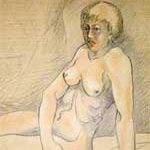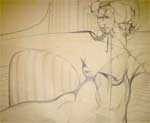Explain
Types of Eating Disorders

- Anorexia Nervosa
- Anorexia Nervosa is characterized by the refusal to eat. It can affect anyone of any gender or age but disproportionately affects young women in their late teens and early twenties.
- According to the most current edition of the Diagnostic and Statistical Manual of Mental Disorders (DSM-IV) there are four criteria that must be present to achieve a diagnosis of Anorexia Nervosa. First a person must refuse to maintain body weight over a minimal normal weight for age and height or have a failure to make expected weight gain during a defined period of growth, resulting in a body weight 15% lower than expected. Second, the person must experience intense fear of gaining weight or becoming fat, even though underweight. Third, the person must have a disturbance in the way his or her body weight, size, or shape is experienced and also experience undue influence of body weight, or shape on self-evaluation, or denial of the seriousness of the current body weight. Finally, amenorrhea must be present. Amenorrhea is the absence of at least three consecutive menstrual cycles when otherwise expected to occur.
- Bulimia Nervosa
- Bulimia Nervosa is characterized by cyclical bingeing and purging episodes. Bingeing is defined as the consumption of more food than most other people would eat in a similar circumstance over a discrete period of time accompanied by a sense of lack of control over the food consumption.
- Bulimia Nervosa exists when bingeing and compensatory behaviors occur on average 2 times weekly or more for a period of at least 3 months, when the behaviors are not exclusively those of Anorexia Nervosa, and when self-evaluation is unduly influenced by body shape or weight. Those with Bulimia are often very concerned about gaining weight and intensely fear getting fat.
- People with Bulimia may engage in a variety of either purging or non-purging behaviors such as vomiting, using laxatives, using diuretics, using enemas, fasting, or exercising excessively. Bulimic bingeing and purging cycles are often conducted in secret because of the shame and disgust associated with the process.
- Binge Eating
- Binge Eating Disorder (BED) is newly-recognized and is characterized by recurrent episodes of binge eating that occur twice weekly or more for a period of at least six months. During bingeing, a larger than normal amount of food is consumed in a short time frame and the person engaging in the bingeing behavior feels a lack of control over the eating.
- In BED, bingeing episodes are associated with at least three characteristics such as eating until uncomfortable, eating when not physically hungry, eating rapidly, eating alone for fear of being embarrassed by how much food is being consumed, or feeling disgusted, depressed or guilty after the episode of overeating. These negative feelings may in turn trigger more bingeing behavior. In addition, although BED behaviors may cause distress by those affected, it is not associated with inappropriate compensatory behaviors such as those found in Bulimia Nervosa or Anorexia Nervosa. Therefore, people with BED often present as either overweight or obese because they consume so many extra calories.
- Anorexia Athletica
- Anorexia Athletica is a constellation of disordered behaviors on the eating disorders spectrum that is distinct from Anorexia Nervosa or Bulimia Nervosa. Although not recognized formally by the standard mental health diagnostic manuals, the term Anorexia Athletica is commonly used in mental health literature to denote a disorder characterized by excessive, obsessive exercise. Also known as Compulsive Exercising , Sports Anorexia, and Hypergymnasia, Anorexia Athletica is most commonly found in pre-professional and elite athletes, though it can exist in the general population as well.
- People suffering from Anorexia Athletica may engage in both excessive workouts and exercising as well as calorie restriction. This puts them at risk for malnutrition and in younger athletes could result in endocrine and metabolic derangements such as decreased bone density or delayed menarche.
- Symptoms of Anorexia Athletica may include over-exercising, obsession with calories, fat, and weight, especially as compared to elite athletes, self-worth being determined by physical performance, and a lack of pleasure from exercising. Advanced cases of Anorexia Athletica may result in physical, psychological, and social consequences as sufferers deny that their excessive exercising patterns are a problem.
- Over Exercise
- “Over exercise” is a general term referring to exercising to the point of exhaustion. Over exercise can occur once in a while as when someone overdoes it on a single work-out, or it can be a habitual behavior. When over exercising becomes the norm, this may be an indication that a person is actually suffering from what is called Obligatory Exercising, Compulsive Exercising, or Anorexia Athletica. When someone over exercises to the point where it is a problem, he or she may experience physical, psychological and social consequences.
- Overeating
- Overeating is not a specific diagnosis of any sort but may rather refer to a discrete incident of eating too much such as during holidays, celebrations, or while on vacation, or it may refer to habitual excessive eating.
- People who engage in overeating regularly tend to eat when not hungry and may eat alone because they are embarrassed about the portions of food they are consuming. In addition, they may spend exorbitant amounts of time fantasizing about their next meal. Another sign that overeating has become a problem is if excessive amounts of money are wasted on food. In general, people who overeat are overweight or obese though people with normal body weights may overeat from time to time as well.
- Overeating becomes problematic when it manifests as a compulsive or obsessive relationship with food. At this point it may be treated with behavior modification therapy or as a food addiction. One program available that supports people in recovering habitual, problematic overeating using the context of an addiction is Overeaters Anonymous (OA). OA is set up similarly to Alcoholics Anonymous (AA) and is a twelve step program in which members acknowledge that they are powerless over food. OA is open to anyone who has an unhealthy relationship with food and who wishes to stop.
- Night Eating
- Night Eating Syndrome (NES) is an emerging condition that is gaining increased recognition among medical professionals. Its clinical importance is in relation to obesity as many people who suffer from NES are overweight or obese and being overweight or obese comes with many negative health risks. Although not classified as one of the types of eating disorders, as a syndrome, NES is considered a constellation of symptoms of disordered eating characterized most prominently by a delayed circadian timing of food intake.
- People with NES tend to not eat in the morning and consume very little during the first half of the day. The majority of their calories are then consumed in the evening hours, so much so that sleep may be disturbed so that a person can eat. People with NES may be unable to get back to sleep after eating or may experience frequent awakenings throughout the night for feedings. However, people with NES are fully awake and aware of their eating episodes.
- It is distinct from bingeing disorders in that the portions consumed are generally those of snacks rather than huge meals. In addition, it differs from Bulimia Nervosa since there are no compensatory or purging behaviors present to offset increased calorie intake.
- Orthorexia
- Orthorexia Nervosa (also known as “orthoexia”) is a term coined by physician Steven Bratman in an article he wrote for Yoga Journal in 1997. It is not a traditionally recognized type of eating disorder but it does share some characteristics with both Anorexia Nervosa and Bulimia, most specifically obsession with food.
- Orthorexia refers to a fixation on eating “pure” or “right” or “proper” food rather than on the quantity of food consumed.
- Having Orthorexia Nervosa is like suffering from Workaholism or Exercise Addiction in which something that is normally considered good or healthy is done in excess and to the point that a person becomes obsessed with the activity. Like other obsessive disorders people with Orthorexia Nervosa experience cyclical extremes, changes in mood, and isolate themselves. Most of their life is spent planning and preparing meals and resisting temptation to the exclusion of other activities. They may even go to the extreme of avoiding certain people who do not share in their dietary beliefs or carry their own supply of food wherever they go.
- Like other eating disorders, Orthorexia Nervosa may result in negative consequences. Social isolation, physical deterioration, and a failure to enjoy life can occur. There have even been a few deaths related to Orthorexia Nervosa when a person becomes so low in body weight due to restrictive eating or fasting that the heart fails.
- EDNOS – Eating Disorder Not Otherwise Specified
- According to the Diagnostic and Statistical Manual, 4th Edition there exists a category of eating disorders that do not meet the specific criteria for the two defined disorders, Anorexia Nervosa and Bulimia. When people exhibit behaviors in the spectrum of disordered eating but do not meet all the criteria for Anorexia Nervosa or Bulimia, they are given a diagnosis of an Eating Disorder Not Otherwise Specified (EDNOS). Over one-half to two-thirds of people diagnosed with eating disorders fall into the category of EDNOS. More people are diagnosed with EDNOS than Anorexia Nervosa and Bulimia combined.
- Binge Eating Disorder (BED) is the only type of eating disorder under the category of EDNOS. A person meets the definition of having EDNOS if they have exhibit all the criteria for Anorexia Nervosa but have regular menstruation or a normal body weight, or if they exhibit all the criteria for Bulimia but purge less than two times per week or for a duration shorter than three months, or if only small amounts of food are purged, or if a person spits out food rather than swallowing it.
- People diagnosed with EDNOS can experience the same negative psychological, social, and physical consequences as a person diagnosed with Anorexia Nervosa or Bulimia. The seriousness of their condition is no different than that for people diagnosed with specific disorders. The only difference is that the person may experience a spectrum of disordered eating behaviors and these behaviors may change over time.
- Although BED is the only one of the types of eating disorders categorized under EDNOS, people who are considered to have Sub Therapeutic Anorexia Nervosa or Sub Therapeutic Bulimia are also given a diagnosis of EDNOS. To have Sub Therapeutic Anorexia Nervosa or Bulimia means that a person displays some but not all of the criteria for the full-blown condition.
Related Articles
In This Article: Compulsive Overeating Overeating Causes Overeating Effects Overeating Symptoms Overeating Treatment Whn looking at Overeating Symptom, a person will typically display the following behavior: frequent episodes of uncontrolled eating, or bingeing, during which the person may not feel “in control” or in command of their own actions. The person may eat rapidly and …
Read More
In This Article: Compulsive Overeating Overeating Causes Overeating Effects Overeating Symptoms Overeating Treatment Typically, the first health care professional to diagnose Compulsive Overeating is a family doctor, pediatrician or internist. After an initial assessment, the person may be referred to either a specialist in eating disorders or an eating-disorder center, which usually provides such specialists …
Read More

“If your motivations regarding food and exercise are based on ‘psychic’ rather than ‘physical’ needs, you need to know that your struggle is important, and worthy of seeking out appropriate medical and/or therapeutic assistance.” –Constance Rhodes, Life Within the Thin Cage According to the Diagnostic and Statistical Manual, 4th Edition there exists a type of …
Read More
Fitness experts recommend that teenagers (12-16 years old) do at least sixty minutes of moderate to vigorous physical activity every day. Most young people today exercise much less than this recommended amount, which exacerbate already exisiting health issues and also lead to obesity, diabetes, high blood pressure, various eating disorders and mental disorders. Some teenagers, …
Read More

The term “over exercise” is not a specific diagnosis complete with a list of symptoms. Instead, it is a general term referring to exercising to the point of exhaustion. Over exercise can occur once in a while as when someone overdoes it on a single work-out, or it can be a habitual behavior. When over …
Read More
The negative effects of over exercising can be physical and emotional. A person may see deterioration of their personal relationships as a result of their compulsions and frsutrations or failure at work or school. Social isolation is common amongst those exercising compulsively as all available time is scheduled with physical activity, usually alone. The physical …
Read More

Night Eating Syndrome (NES), is an emerging condition that is gaining increased recognition among medical professionals. Its clinical importance relates to obesity as many people who suffer from night eating syndrome overeat; being overweight or obese comes with many negative health risks. Although not classified as an eating disorder, as a syndrome, night eating syndrome …
Read More
In this Article: Night Eating Night Eating Symptoms Night Eating Treatment Night Eating Symptoms Excessive eating during night hours Binging during night hours Skipping of breakfast meal or snack at least four times per week Consuming more than half of ones daily calories after 7pm Irritability during night time hours Insomnia Hormone changes Mood swings …
Read More
In this Article: Night Eating Night Eating Symptoms Night Eating Treatment Here are some options for Night Eating Treatment: 1. Eat breakfast. Most people with Night Eating Disorder aren’t hungry in the morning. But if they can learn to stomach a morning meal, it can help stop their nighttime overeating, says psychologist Marci Gluck at …
Read More

Orthorexia nervosa (also spelled “orthoexia”) is a term coined by physician Steven Bratman in an article he wrote for Yoga Journal in 1997. It is not a traditionally recognized eating disorder but it does share some characteristics with both anorexia nervosa and bulimia, most specifically obsession with food. However, orthorexia nervosa refers to a fixation …
Read More
 Eating Disorder Self Test. Take the EAT-26 self test to see if you might have eating disorder symptoms that might require professional evaluation. All answers are confidential.
Eating Disorder Self Test. Take the EAT-26 self test to see if you might have eating disorder symptoms that might require professional evaluation. All answers are confidential.
Find a Treatment Facility Near You
Click on a state below to find eating disorder treatment options that could be right for you.





 Eating Disorder Self Test. Take the EAT-26 self test to see if you might have eating disorder symptoms that might require professional evaluation. All answers are confidential.
Eating Disorder Self Test. Take the EAT-26 self test to see if you might have eating disorder symptoms that might require professional evaluation. All answers are confidential.